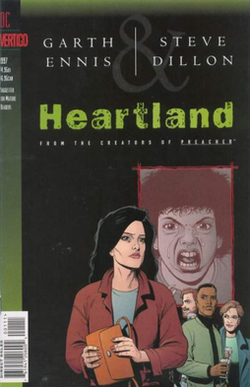| Heartland | |
|---|---|
 Cover to Heartland (March 1997). Pencils and inks by Steve Dillon, colors by Matt Hollingsworth, design by Henry Yee. | |
| Publication information | |
| Publisher | Vertigo |
| Schedule | One-shot |
| Format | Limited series |
| Publication date | March 1997 |
| No. of issues | 1 |
| Creative team | |
| Written by | Garth Ennis |
| Penciller(s) | Steve Dillon |
| Inker(s) | Steve Dillon |
| Letterer(s) | Clem Robbins |
| Colorist(s) | Daniel Vozzo |
| Editor(s) | Julie Rottenberg |
| Collected editions | |
| Rake at the Gates of Hell | ISBN 1-4012-0002-8 |
Heartland is a comic book one-shot published by the Vertigo imprint of DC Comics in March 1997. It was written by Garth Ennis and illustrated by Steve Dillon. It is a spin-off from the Hellblazer comic book series, and features the character of Kit Ryan, a longtime supporting character in that series. Although Heartland is technically a spin-off of Hellblazer, the central character of that series, John Constantine, makes no appearance. [1]